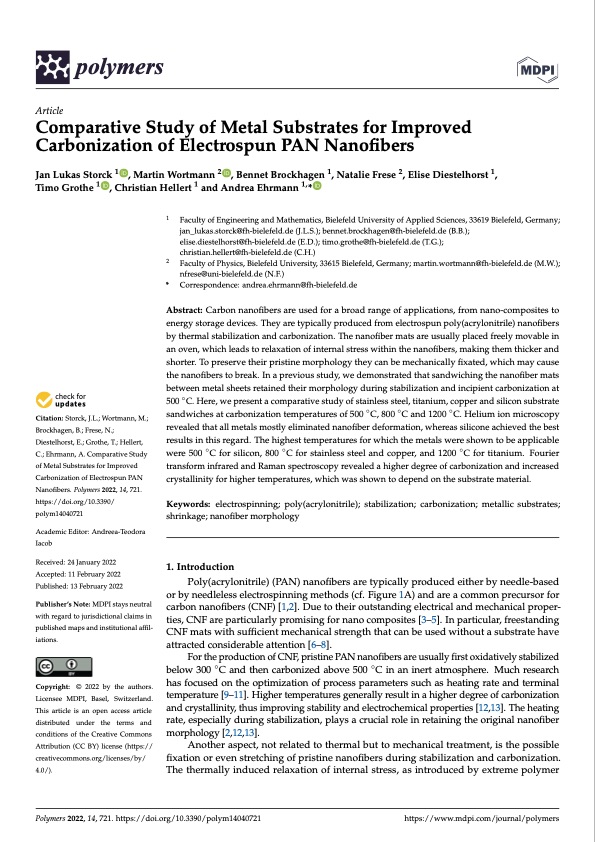
PDF Publication Title:
Text from PDF Page: 001
polymers Article Comparative Study of Metal Substrates for Improved Carbonization of Electrospun PAN Nanofibers Jan Lukas Storck 1 , Martin Wortmann 2 , Bennet Brockhagen 1, Natalie Frese 2, Elise Diestelhorst 1, Timo Grothe 1 , Christian Hellert 1 and Andrea Ehrmann 1,* Citation: Storck, J.L.; Wortmann, M.; Brockhagen, B.; Frese, N.; Diestelhorst, E.; Grothe, T.; Hellert, C.; Ehrmann, A. Comparative Study of Metal Substrates for Improved Carbonization of Electrospun PAN Nanofibers. Polymers 2022, 14, 721. https://doi.org/10.3390/ polym14040721 Academic Editor: Andreea-Teodora Iacob Received: 24 January 2022 Accepted: 11 February 2022 Published: 13 February 2022 Publisher’s Note: MDPI stays neutral with regard to jurisdictional claims in published maps and institutional affil- iations. Copyright: © 2022 by the authors. Licensee MDPI, Basel, Switzerland. This article is an open access article distributed under the terms and conditions of the Creative Commons Attribution (CC BY) license (https:// creativecommons.org/licenses/by/ 4.0/). 1 Abstract: Carbon nanofibers are used for a broad range of applications, from nano-composites to energy storage devices. They are typically produced from electrospun poly(acrylonitrile) nanofibers by thermal stabilization and carbonization. The nanofiber mats are usually placed freely movable in an oven, which leads to relaxation of internal stress within the nanofibers, making them thicker and shorter. To preserve their pristine morphology they can be mechanically fixated, which may cause the nanofibers to break. In a previous study, we demonstrated that sandwiching the nanofiber mats between metal sheets retained their morphology during stabilization and incipient carbonization at 500 ◦C. Here, we present a comparative study of stainless steel, titanium, copper and silicon substrate sandwiches at carbonization temperatures of 500 ◦C, 800 ◦C and 1200 ◦C. Helium ion microscopy revealed that all metals mostly eliminated nanofiber deformation, whereas silicone achieved the best results in this regard. The highest temperatures for which the metals were shown to be applicable were 500 ◦C for silicon, 800 ◦C for stainless steel and copper, and 1200 ◦C for titanium. Fourier transform infrared and Raman spectroscopy revealed a higher degree of carbonization and increased crystallinity for higher temperatures, which was shown to depend on the substrate material. Keywords: electrospinning; poly(acrylonitrile); stabilization; carbonization; metallic substrates; shrinkage; nanofiber morphology 1. Introduction Poly(acrylonitrile) (PAN) nanofibers are typically produced either by needle-based or by needleless electrospinning methods (cf. Figure 1A) and are a common precursor for carbon nanofibers (CNF) [1,2]. Due to their outstanding electrical and mechanical proper- ties, CNF are particularly promising for nano composites [3–5]. In particular, freestanding CNF mats with sufficient mechanical strength that can be used without a substrate have attracted considerable attention [6–8]. For the production of CNF, pristine PAN nanofibers are usually first oxidatively stabilized below 300 ◦C and then carbonized above 500 ◦C in an inert atmosphere. Much research has focused on the optimization of process parameters such as heating rate and terminal temperature [9–11]. Higher temperatures generally result in a higher degree of carbonization and crystallinity, thus improving stability and electrochemical properties [12,13]. The heating rate, especially during stabilization, plays a crucial role in retaining the original nanofiber morphology [2,12,13]. Another aspect, not related to thermal but to mechanical treatment, is the possible fixation or even stretching of pristine nanofibers during stabilization and carbonization. The thermally induced relaxation of internal stress, as introduced by extreme polymer Faculty of Engineering and Mathematics, Bielefeld University of Applied Sciences, 33619 Bielefeld, Germany; jan_lukas.storck@fh-bielefeld.de (J.L.S.); bennet.brockhagen@fh-bielefeld.de (B.B.); elise.diestelhorst@fh-bielefeld.de (E.D.); timo.grothe@fh-bielefeld.de (T.G.); christian.hellert@fh-bielefeld.de (C.H.) 2 nfrese@uni-bielefeld.de (N.F.) Faculty of Physics, Bielefeld University, 33615 Bielefeld, Germany; martin.wortmann@fh-bielefeld.de (M.W.); * Correspondence: andrea.ehrmann@fh-bielefeld.de Polymers 2022, 14, 721. https://doi.org/10.3390/polym14040721 https://www.mdpi.com/journal/polymersPDF Image | Carbonization of Electrospun PAN Nanofibers

PDF Search Title:
Carbonization of Electrospun PAN NanofibersOriginal File Name Searched:
polymers-14-00721.pdfDIY PDF Search: Google It | Yahoo | Bing
Sulfur Deposition on Carbon Nanofibers using Supercritical CO2 Sulfur Deposition on Carbon Nanofibers using Supercritical CO2. Gamma sulfur also known as mother of pearl sulfur and nacreous sulfur... More Info
CO2 Organic Rankine Cycle Experimenter Platform The supercritical CO2 phase change system is both a heat pump and organic rankine cycle which can be used for those purposes and as a supercritical extractor for advanced subcritical and supercritical extraction technology. Uses include producing nanoparticles, precious metal CO2 extraction, lithium battery recycling, and other applications... More Info
| CONTACT TEL: 608-238-6001 Email: greg@infinityturbine.com | RSS | AMP |